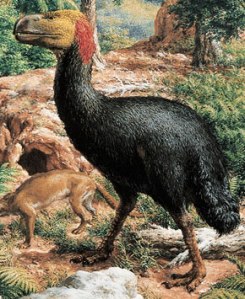
The “terror bird” Gastornis (http://research.amnh.org/)
For many of us being an early bird becomes progressively more difficult as conference fatigue takes its toll. I was glad to see a sizeable crowd managed to be there for the start of our session on the role of biominerals in biogeochemical cycling, which happened to be about birds and worms, and some other creatures.
Thomas Tütken showed us that the fearsome Eocene terror bird was neither a predator, nor a worm-catcher, but a gentle herbivorous giant instead! Also, the oxygen isotope composition of the bones of large herbivores forms a remarkably good archive of Cenozoic climate, agreeing well with the famous Zachos curve.
Then it was my turn to talk about worms, who are unexpected biomineralisers, and appear to precipitate atmospheric carbon dioxide in carbonate granules in the soil. Loredana Brinza studied metals in these granules, and demonstrated that they can significantly contribute to zinc immobilisation in polluted soils.
From animals we switched to plants, with two presentations about phytoliths: little chunks of silica produced by plants. Jean-Dominique Meunier and Eric Struyf showed that the contribution of phytoliths to global silicium cycling is much larger than previously thought and is of the same order of magnitude as the marine contribution of diatoms. Humans remove a lot of silicium from the global cycle by harvesting crops, and this likely reduces crop yields.
Going from the terrestrial to the marine realm, Ruth Carmichael spoke about nitrogen in bivalves and their potential for nitrogen sequestration as well as reconstruction of nitrogen cycling before human influences, using shells from middens that are thousands of years old. Adilah Ponnurangam stayed with the bivalves, but looked at rare-earth elements and showed that they reflect seawater composition.
The session ended with Michaël Hermoso presenting some meticulous laboratory culture experiments on coccolithophores, and size-related differences in carbon-isotope fractionation. All-in-all a very interesting morning, and a satisfying debut as a session chair.



